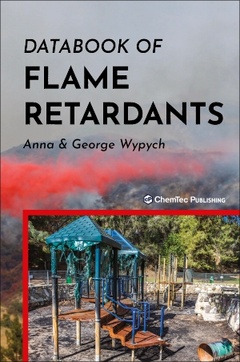Description
Databook of Flame Retardants
Language: English
Subjects for Databook of Flame Retardants:
Keywords
fluoropolymers; hydroxides; graphite; antimonates; siloxanes; halogenated; intumescent; additives
Publication date: 01-2021
494 p. · 15.2x22.8 cm · Hardback
494 p. · 15.2x22.8 cm · Hardback
Description
/li>Contents
/li>Biography
/li>Comment
/li>
Databook of Flame Retardants contains information on commonly-used additives broken out into five sections, including General, Physical, Health and Safety, Ecological, and Use. Over one hundred types of data are included for over three hundred and fifty commercial-based products. All data fields are defined and include a broad range of information, such as calcium contents, molecular mass, brightness, freezing/melting points, viscosity, volatility, UN/NA class, autoignition temperature, partition coefficient, processing methods, concentrations used, and more. This book is best utilized in tandem with the Handbook of Flame Retardants.
Each book complements the other without repeating information, with the other release explaining the role of these products, their selection, mechanism of action, use in different polymers and products, and health and commercial issues related to flame retardants.
Each book complements the other without repeating information, with the other release explaining the role of these products, their selection, mechanism of action, use in different polymers and products, and health and commercial issues related to flame retardants.
1. Introduction to Flame Retardants
2. Information on the Data Fields of Flame Retardants
3. Properties of Flame Retardants
2. Information on the Data Fields of Flame Retardants
3. Properties of Flame Retardants
Anna Wypych studied chemical engineering and polymer chemistry and obtained an M.Sc in chemical engineering. Her professional expertise includes both teaching and research & development. She specializes in polymer additives for PVC and other polymers, and evaluates their effect on health and environment.
George Wypych has a Ph.D. in chemical engineering. His professional expertise includes both university teaching (full professor) and research and development. He has published 18 books, 47 scientific papers, and he has obtained 16 patents. He specializes in polymer additives, polymer processing and formulation, material durability and the development of sealants and coatings.
George Wypych has a Ph.D. in chemical engineering. His professional expertise includes both university teaching (full professor) and research and development. He has published 18 books, 47 scientific papers, and he has obtained 16 patents. He specializes in polymer additives, polymer processing and formulation, material durability and the development of sealants and coatings.
- Provides key physical, health and safety, ecological, and application data for over 350 commonly-used fire retardant additives
- Covers halogenated, inorganic, phosphorus, intumescent, and nitrogen-based fire retardants
- Data listed includes CAS #, chemical class and name, decomposition temperature, electrical conductivity, IMDG class, biodegradation probability, product and resin recommendations, guidelines for use, and more
© 2024 LAVOISIER S.A.S.
These books may interest you

Databook of Biocides 215.20 €

Databook of Antioxidants 274.96 €

Handbook of Flame Retardants 285.83 €

